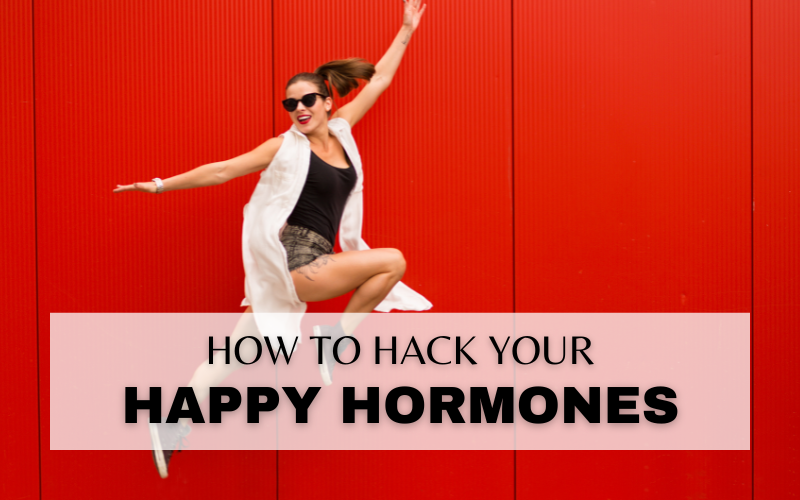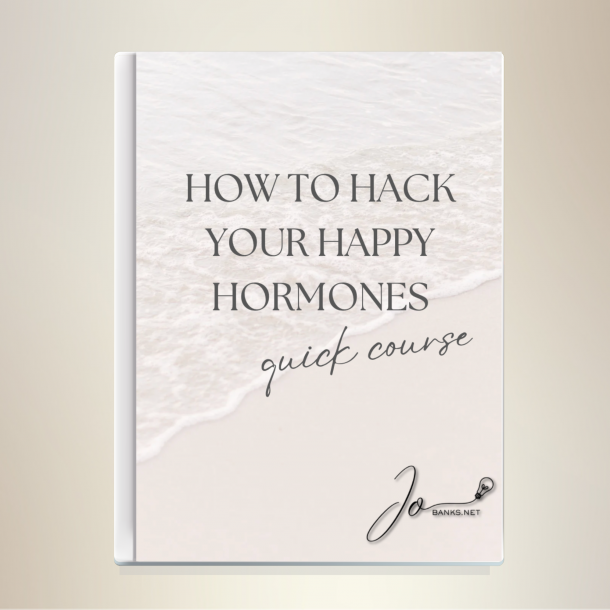Audio Version (10:19)
The hormones dopamine, oxytocin, serotonin and endorphins significantly impact our physical and mental health. Being low in any of these biochemicals can have a massively detrimental effect, yet they’re rarely discussed or understood.
Luckily, some straightforward ways to hack our ‘happy hormones’ exist. In this article, I’m discussing the four different hormones, what they are responsible for, the symptoms of low levels, and how to boost them safely to feel happier and healthier.
To watch the extended YouTube version of this article, click here.

Overview
When we undertake certain activities, we release specific combinations of neurochemicals. Once you’re aware of your ‘happy’ hormones, what each one is responsible for and how to activate them, you can choose to undertake activities that force their release.
This enhances your physical and mental well-being and effectively combats stress, anxiety, lethargy, demotivation, and low mood.
Dopamine – The Reward Chemical
What is Dopamine?
Dopamine is often referred to as the reward chemical as it gets released in response to achieving/ accomplishing our goals (large or small) or when we feel that we’re on the right track towards their attainment.
Dopamine is closely connected to motivation levels, i.e. if you’re highly motivated, your dopamine levels are good; if you’re unmotivated, they’re likely low. You can get a dopamine ‘hit’ from many different sources.
However, not all sources of dopamine are beneficial. Some can be incredibly harmful and can cause addictions. Therefore, it’s vital to understand how to access this critical hormone without causing potentially long-lasting damage.
Symptoms of Low Dopamine
Muscle cramps, spasms, or tremors
Aches and pains
Stiffness in the muscles
Loss of balance
Constipation
Difficulty eating and swallowing
Weight loss or weight gain
Frequent pneumonia
Trouble sleeping or disturbed sleep
Low energy
An inability to focus
Moving or speaking more slowly than usual
Feeling fatigued
Feeling demotivated
Feeling inexplicably sad or tearful
Mood swings
Feeling hopeless
Low self-esteem
Feeling guilt-ridden
Anxiety
Low sex drive
Lack of insight or self-awareness
How to Safely Access Dopamine
Celebrating wins (large or small)
Rewarding ourselves after completing a task
Undertaking self-care activities, e.g. meditation, massage, warm bubble bath, pampering, reading a favourite book, etc.
Ticking things off a list
Eating good, satisfying, wholesome food
Completing a challenging exercise workout
Going for a long walk in the countryside
Playing with children or pets
Cooking a wonderful meal
Receiving validation and good feedback from others
Getting creative, painting, drawing, needlework, DIY
Working on our hobbies
Finding solutions to problems – the more complex, the better
The list is endless!
(I talk about dopamine, including addiction, in more detail in the video version.)
Oxytocin – The Love Hormone
What is Oxytocin?
Oxytocin acts as a chemical messenger in the brain and is integral to human behaviours, including sexual arousal, recognition, trust, anxiety, and mother-infant bonding.
It can be traced back to our earliest ancestors when separating from the ‘tribe’ meant certain death. We simply could not survive on our own, out in the open, without the protection of the wider group. Therefore, having close bonds was critical to ensuring our survival. That’s where oxytocin comes in.
Anyone experiencing prolonged periods alone will likely be low in oxytocin. So, for example, during lockdown, if you were living AND working on your own (and don’t own a pet – we get oxytocin from playing/stroking pets) and spending little or no time with others, undoubtedly, your oxytocin levels will have been low.
Symptoms of Low Oxytocin Levels
Poor communication
Irritability/agitation
Inability to feel affectionate
More anxieties and fears than normal
Increased appetite for sugar-rich foods
Experiencing little joy from life
Disturbed sleep
Prolonged healing
Low mood
Lethargy/inability to motivate self
Stress and anxiety
Despair
Loneliness
Unexplained aches and pains
Low appetite
Sadness
Low mood
How to Safely Access Oxytocin
Hugging (if you can hug someone for 15 seconds or more, the effects get heightened – even more so if you’re both naked!)
Prolonged physical touching, e.g. holding hands, massage
Exercising with others
Sports, music, theatre events – anywhere where there are large groups of people, especially if you all have a common goal, e.g. football
Playing with a baby/children
Playing with a pet
Laughing with others
Sharing experiences (storytelling)
Holistic treatments such as massage, Reiki, physiotherapy, etc.
Giving a compliment face-to-face or even virtually
Serotonin – The Mood Stabiliser
What is Serotonin?
Serotonin is responsible for several internal processes, including sleep, regulating appetite, promoting learning and memory, increasing positive feelings and emotions, and overall mood stability.
Serotonin gets activated when daylight hits the back of our eyes when we are outside; this must be DIRECT exposure, i.e. not through a window. S.A.D. (Seasonal Affective Disorder) is a direct result of a lack of serotonin release.
Symptoms of Low Serotonin
Low mood
Aggression
Stress
Low self-esteem
Depression
Anxiety
Sleep issues
Not being able to fall asleep
Waking in the middle of the night
Insomnia
Chronic pain
Appetite issues
Hyperactivity (difficulty concentrating)
Memory and learning issues
Craving high-sugar/high-fat carbs
Impulsive behaviour
Poor memory
How to Safely Access Serotonin
Exercise
Meditation
Massage and holistic therapies, e.g. Reiki and physiotherapy
Daylight exposure
Walking, running, cycling outdoors, especially in nature
Eating wholesome, unprocessed natural foods, e.g. whole-wheat, oatmeal, brown rice and pasta, oily fish, fruit, and nuts.
Visualisation
Practising gratitude
Endorphins – The Pain Killer
What are Endorphins?
Endorphins are neurotransmitters responsible for making you feel happy. They minimise discomfort and pain and maximise pleasure.
Recent studies suggest that they play an essential role in reducing stress, anxiety, and depression and are critical to our overall well-being.
We use the term ‘runners high’ in reference to the euphoria people feel after strenuous exercise. The elated mood can be primarily attributed to the massive endorphin release we experience when we exercise.
Symptoms of Low Endorphin Levels
Muscle stiffness
Fatigue
Low energy
Sleep problems
Aches and pains
Prolonged recovery time after illness
Prolonged recovery after exercise
Mood swings
Anxiety
Depression
Weight issues
Impulsive behaviours
Headaches
Low self-esteem
How to Safely Boost Endorphin Levels
Exercising (especially with others)
Laughing out loud (especially with others)
Watching comedy programmes or movies
Watching live comedy
Massage and holistic therapies
Eating wholesome, unprocessed foods
Eating dark chocolate and drinking red wine (in moderation!)
Dancing and singing
Listening to uplifting music
Helping others
Undertaking creative activities
The Wrap-Up
As our biochemicals are so critical to our physical and mental health, it’s vital to weave activities into your daily routine that will safely activate their release.
I recommend choosing at least one thing you can do each day to stimulate each of the four happy biochemicals.
Give some thought to any obstacles that may stop you from following through and how you will overcome them. That’s one of the fundamental keys to habit formation.
If you’d like more information on this topic, I have a free pdf-based mini-course, which includes an A4 poster of the four biochemicals and how to hack them, which you can print off to remind you. Click here to receive your copy.
What Next?
If you have anything you’d like to add on this topic, or if you have any questions you’d like me to answer, please leave them in the comments section below. I love interacting with you and really value your feedback.
If you want to watch the extended YouTube version, click here. If you do head to YouTube, please like, comment, subscribe, and hit that notification bell so you don’t miss a thing.
I need 1,000 YouTube subscribers to be able to do ‘live’ streaming, and I’m only 130 away! So, if you could help me with that, I’d be incredibly grateful. It’s completely free, and I don’t have access to your email address or any other personal details.
If you enjoyed this article and haven’t yet subscribed to get my newsletter straight to your email inbox, click the ‘newsletter’ tab at the top of the page.
Finally, as always, thank you for your continued support.



